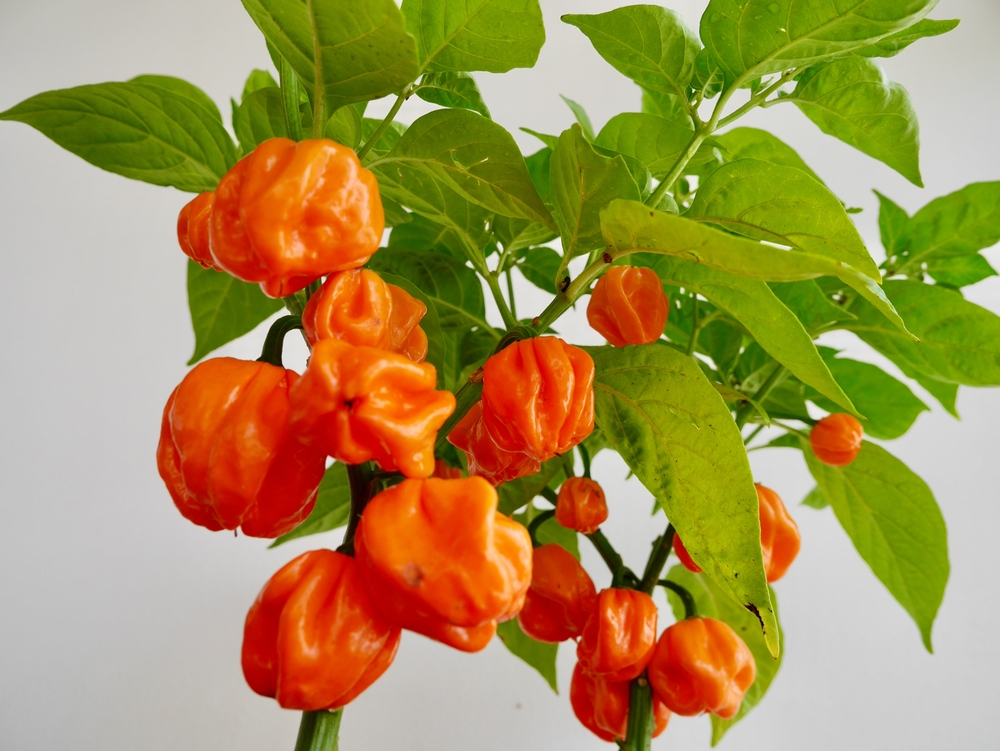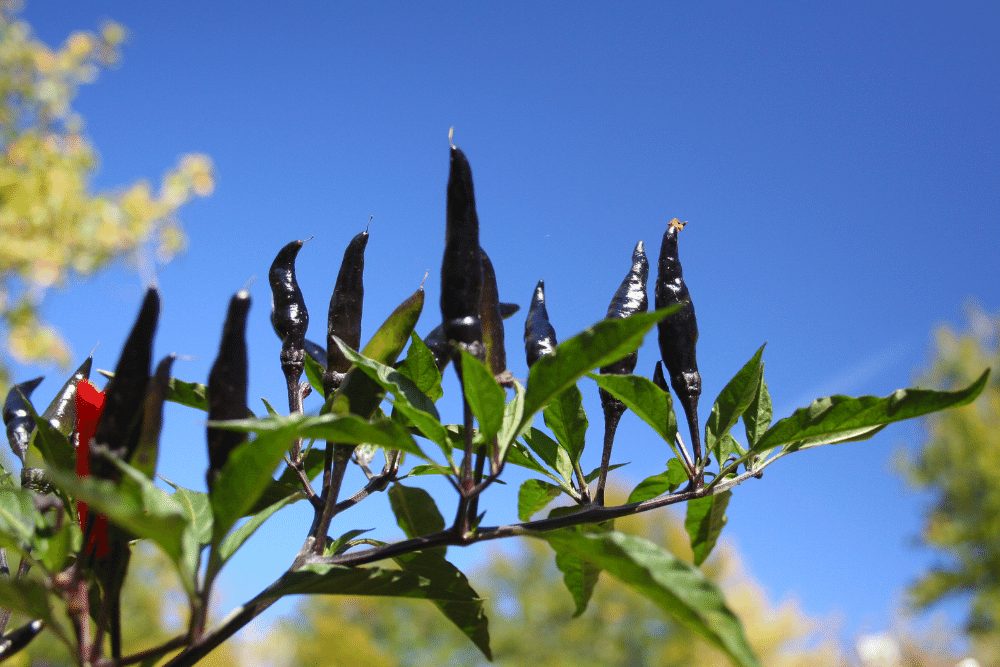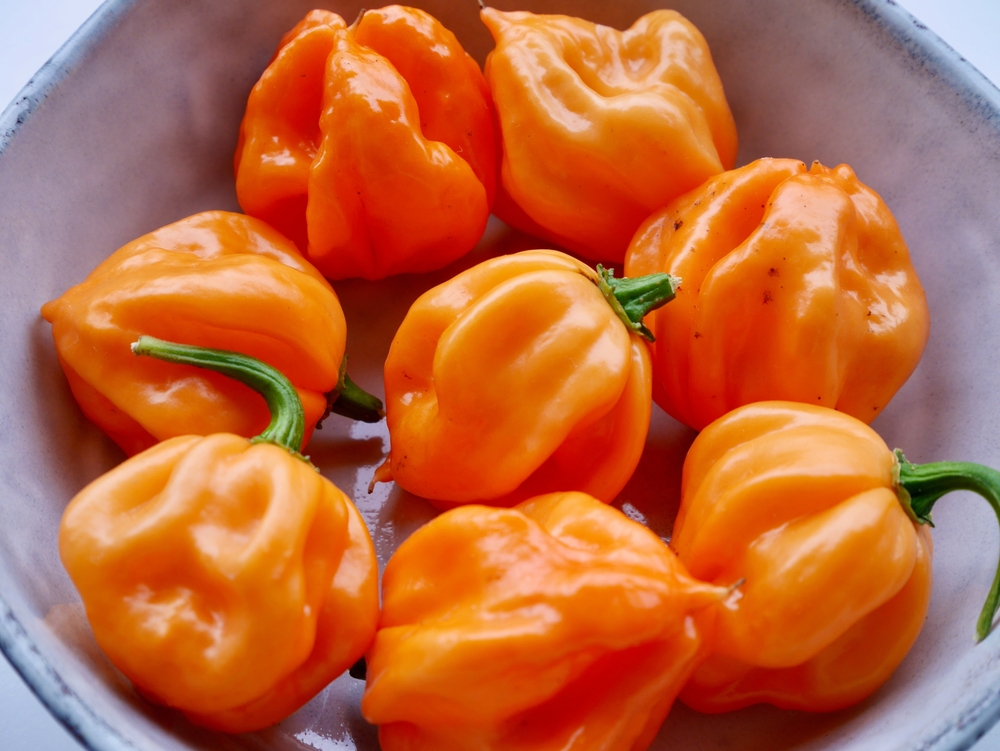Goat peppers are native to the Bahamas and cultivated for their spicy kick, high productivity, and tropical flavor. They are closely related to habaneros and scotch bonnet peppers in the Capsicum chinense species.
What Is A Goat Pepper?
A goat pepper is a Capsicum chinense chili pepper native to the islands of the Bahamas in the Caribbean. Also called the Bahamian goat pepper, the goat pepper is a popular pepper and the hottest in the Bahamas.
The name of the pepper is a mystery. Some legends say the pepper is named so because of its spiciness, akin to an angry goat’s painful kick.
Others say the pepper is called goat pepper because it has the unmistakable aroma of a goat when you cut the pepper open. Yet others say it gets its name from its ugliness. But are goats really ugly?
Since the Bahamas is a goat farming area, another legend says the pepper’s prevalence tends to be in areas where the goats forage.
Color
The color of goat peppers goes from dark green in their early stages to peach or light orange at full maturity.
Shape And Size
The goat pepper matches scotch bonnet peppers’ shape, heat, and flavor profile. They are also closely related to habaneros and match their heat and flavor.
Goat peppers are round peppers with slightly squashed pods with ridges running vertically along the sides. The squashed profile and vertical ridges make the peppers look like mini-pumpkins.
Scotch bonnet peppers also have a similar slightly squashed profile.
Some goat peppers have a small scorpion tail like the one seen in Trinidad Moruga scorpion or scorpion peppers. The ones with the tail are very rare. Instead, most goat peppers have a bulbous bottom.
Bahamian goat peppers reach 2-3 inches long at full maturity.
Texture
If you go by the ugly legend, you might not love the look of the goat pepper. Its skin is ribbed, indented, and bulbous.
Flavor
Goat peppers have a sweet, fruity, citrusy flavor with strong hints of lemon. The tropical flavor means they pair well with other tropical fruits like pineapples and mangoes.
Habaneros and scotch bonnet peppers, both close relatives of goat peppers, have a similar flavor profile. Habaneros have a sweet, fruity flavor with subtle undertones of smokiness. Scotch bonnets have a sweet, slightly fruity tropical flavor.

What Is The Difference Between Scotch Bonnet and Goat pepper?
Scotch bonnet peppers and goat peppers are similar. As mentioned, they are close relatives that share common attributes like flavor, size, shape, and spiciness.
The main notable differences are their color and shape. While goat peppers are green and ripen to peach or orange, scotch bonnet hot peppers ripen from green to orange, red, yellow, or brown.
Both peppers have ribs and a squashed profile, but the Scotch bonnets look more refined. Their ribs aren’t as rough and unevenly set. They also lack the bulbous bottom and many indentations.
Another difference between the two peppers is that while goat peppers are a single pepper variety, scotch bonnet peppers have different varieties. Popular varieties of the Scotch bonnet include:
- The Jamaican Hot
- The Bahama Mama
- The Bahamian
- The Martinique
What Is The Difference Between Goat Pepper And Goat’s Weed Pepper?
By the closeness of names, you may confuse the goat pepper with the goat’s weed pepper, also called the black cobra pepper.
The goat’s weed pepper is a Capsicum annuum ornamental hot pepper native to Venezuela. It’s known for its silvery hair, upright growth, high productivity, and beautiful elongated black peppers that finally ripen to red.

How Hot Is Goat Pepper?
Legends don’t liken the spicy kick of the goat pepper to the kick of an angry goat for nothing. Goat peppers come in smoking hot at 100,000-350,000 Scoville Heat Units—the same heat level as orange habaneros, wiri wiri, and scotch bonnet peppers.
Other Capsicum chinense pepper varieties in the kicking-hot category include bhut jolokia, naga morich, fatalii, and devil’s tongue peppers.
What Is Goat Pepper Used For?
You can use goat peppers to make goat pepper hot sauce. The peppers have a thin skin, making them ideal for drying and processing into hot chili powder, hot sauces, marinades, and rubs.
You can also use goat peppers to make tropical hot sauces. Since it has the same heat level and flavor profile as habanero peppers, you could try them in mango habanero hot sauce.
If you want to try some goat pepper recipes, try Bahamian chicken souse, spicy conch salad, or spicy coconut chicken curry.
Remember, you can use goat peppers in any recipe that calls for habanero or scotch bonnet peppers!
Where To Buy Goat Peppers
Goat peppers are rare and hard to find raw outside the Caribbean. In the US, you might find them at Caribbean specialty stores.
Can You Grow Goat Bahamian Goat Pepper?
As with most other rare peppers, growing your own is usually the best option.
Like other Capsicum chinense peppers, the goat pepper takes its sweet time to reach full maturity. The peppers mature in 90-120 days after transplanting.
Bahamian goat pepper seeds are available online from seed catalogs and Amazon. You’ll need to start the seeds indoors before the last frost as goat peppers develop slowly.
When the seedlings are ready, transplant them outdoors in full sun in the garden or large containers. You’ll have to provide partial shade in the summer in extreme heat to protect the leaves from sunburn. You can overwinter the plants indoors in a sunny window or under grow bulbs.
Since goat pepper plants have dense foliage, they require trimming during the fall to improve airflow and offer enough space to produce fruits.
Substitutes For Bahamian Goat Pepper
Goat peppers can be substituted with other hot Capsicum chinense pepper varieties such as:
- Orange habaneros (100,000-350,000 SHUs).
- Scotch bonnet peppers (100,000-350,000 SHUs).
- Fatalii peppers—habanero relatives with an earthy, sweet, fruity, citrusy flavor and 125,000-325,000 SHUs.
- Roatan pumpkin habanero—believed to be a hybrid between habaneros and Scotch bonnet peppers. These have a sweet, fruity, citrusy flavor but are potentially hotter at 100,000-500,000 SHUs.
- Chocolate habaneros (425,000-577,000 SHUs).
- Caribbean red habaneros (300,000-500,000 SHUs).
- Red savina habaneros—believed to be a Caribbean red habanero mutant with a sweet, almost fruity flavor and 350,000-577,000 SHUs.
- Devil’s tongue habanero or Devil’s tongue pepper—believed to be a hybrid between Fatalii and habaneros. These peppers have a sweet, slightly tangy, fruity, citrusy flavor and 125,000-325,000 SHUs.

